Coelophysoids
|
The Theropoda are the bipedal, predominantly carnivorous dinosaurs. Birds are members of this clade. The earliest, basal theropods (branch near the base of the theropod tree) were relatively small, slender, agile predators.
Coelophysis bauri is a good example of this (probably paraphyletic) group.
Taxonomy: Theropoda, Basal Theropods, Coelophysidae
Chinle Formation, Rio Arriba Co., NM
Late Triassic Period, 225 Ma
Denver Museum of Science & Nature
|
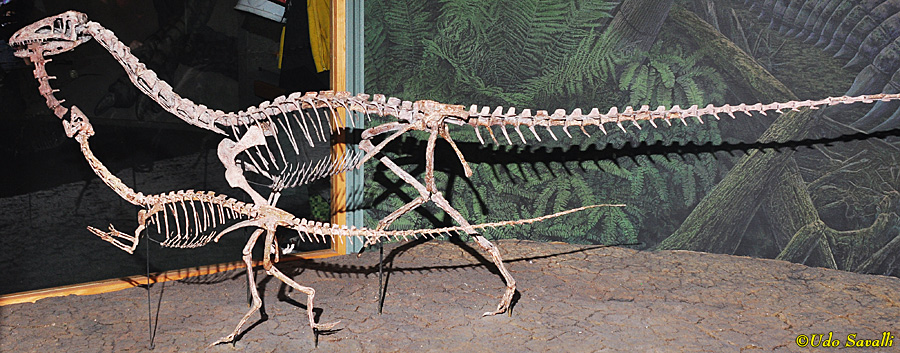
|
|
|
Coelophysis bauri fossil cast.
Taxonomy: Theropoda, Basal Theropods, Coelophysidae
Kayenta Formation, Ghost Ranch, NM
Late Triassic Period, 220 Ma
Black Hills Institute Museum, South Dakota
|
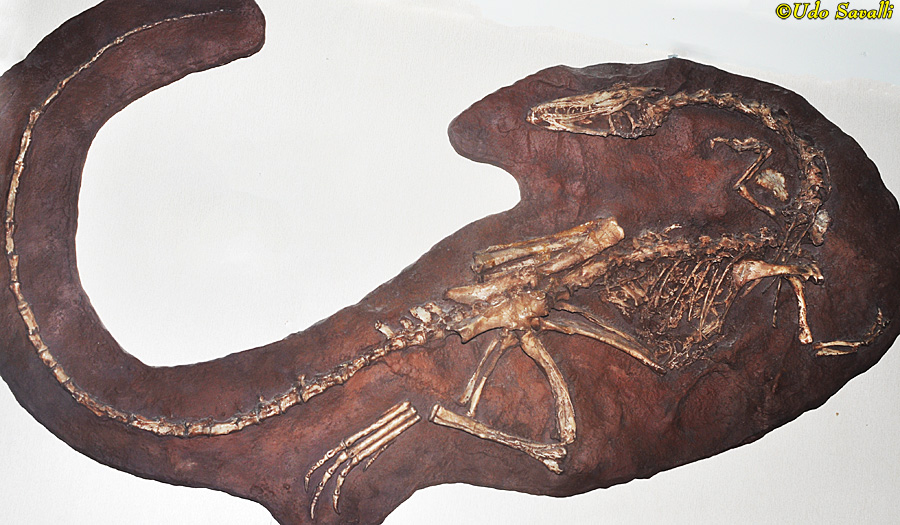
|
|
|
Coelophysis bauri fossil block. Coelophysis fossils have been found in large groups (note additional skeletons at the left edge and upper right), suggesting they were social in life.
Taxonomy: Theropoda, Basal Theropods, Coelophysidae
Ghost Ranch, New Mexico
Late Triassic Period, 216-204 Ma
New Mexico Museum of Natural History & Science
|
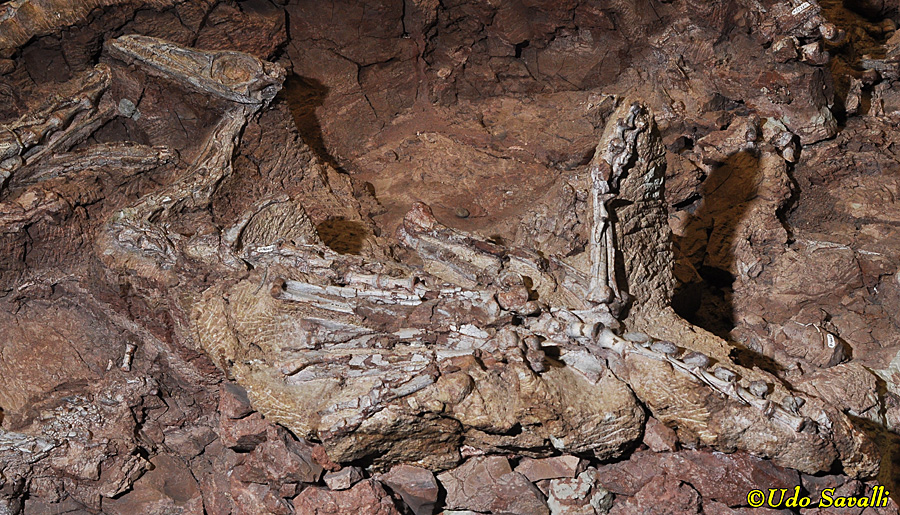
|
|
|
Life model of Coelophysis sp.
Taxonomy: Dinosauria; Therapoda; Coelophysidae
Late Triassic Period
Arizona Museum of Natural History
|
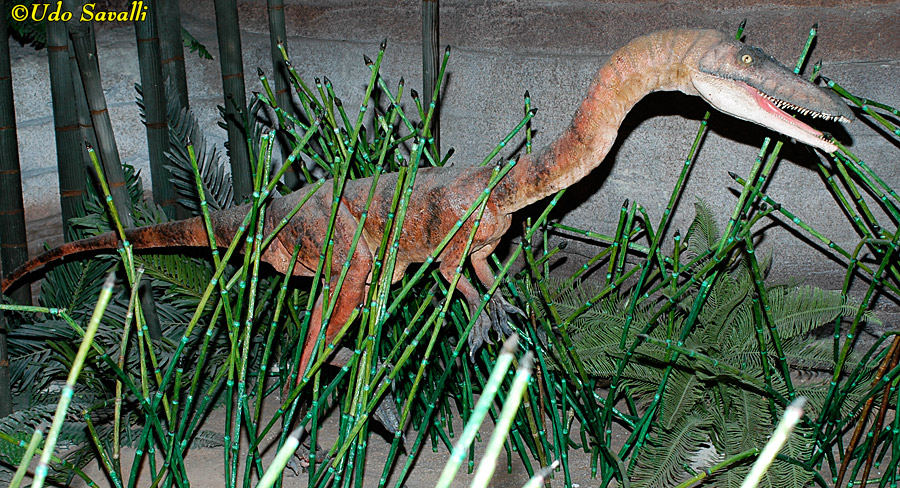
|
|
|
Life model of Megapnosaurus kayentakatae, a close relative of Coelophysis that is sometimes included in that genus.
Taxonomy: Dinosauria; Therapoda; Coelophysidae
Early Jurassic Period; Utah
Dinosaur Discovery Site, Utah
|
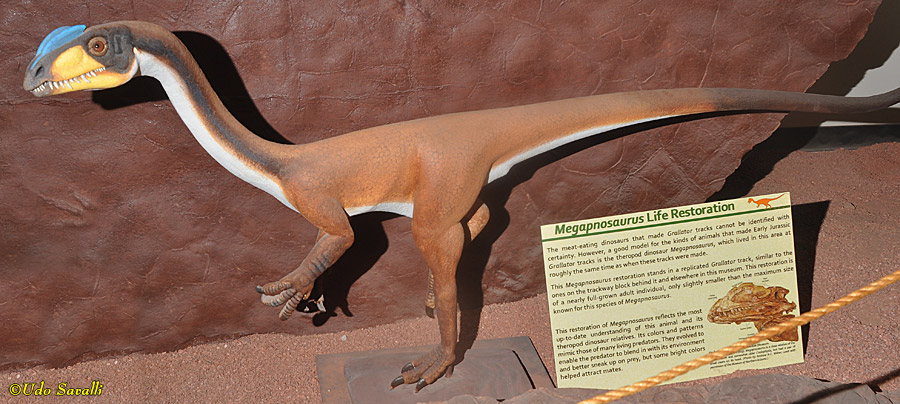
|
|
|
Dilophosaurus wetherilli was one of the first moderately large theropods. Its thin, hollow crests probably functioned in display. A recent (2020) reexamination of specimens suggests that the notch in the upper jaw was not as large as reconstructed here and that the crests were somewhat differently shaped as well.
Taxonomy: Theropoda, Basal Theropods, Dilophosauridae
Arizona
Early Jurassic Period, 200-185 Ma
Northern Arizona Museum, Flagstaff
|
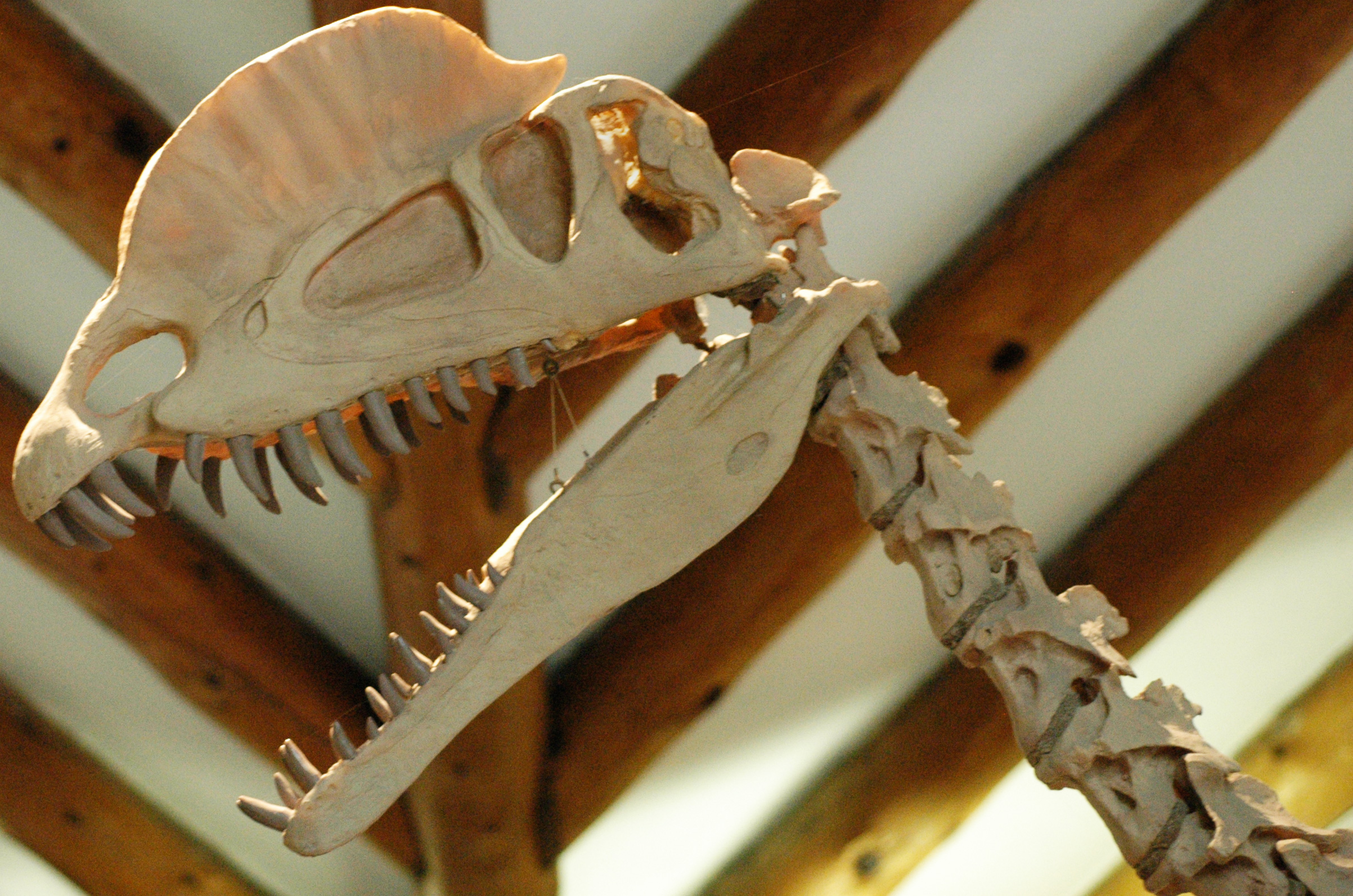
|
|
|
Life model of Dilophosaurus wetherilli. Recent reconstructions suggest that the crests are shaped a bit differently and the notch in the upper jaw would not be noticable in life.
Taxonomy: Dinosauria; Therapoda;
Early Jurassic Period, 193 Ma; Arizona
Arizona Museum of Natural History
|
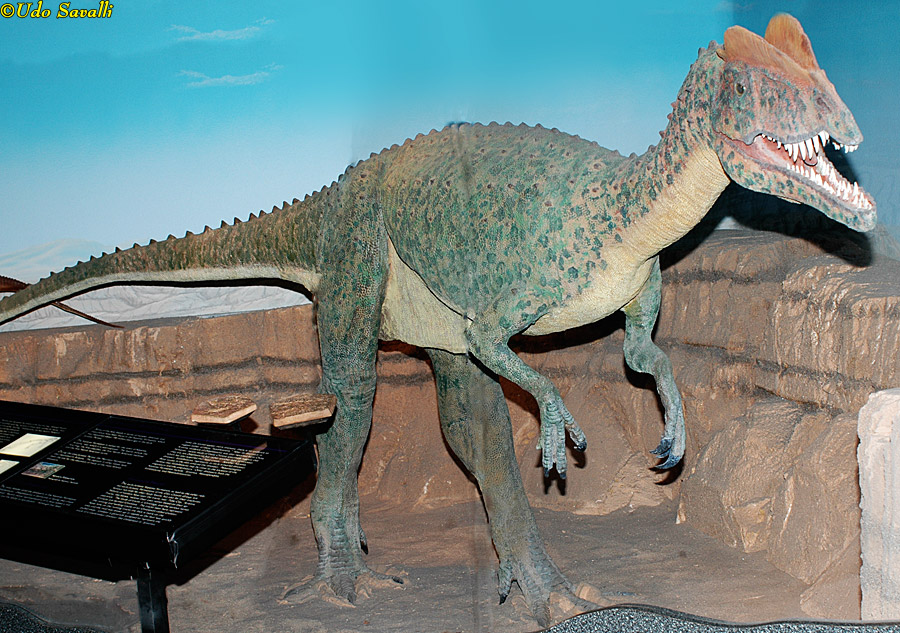
|
|
|
Sinosaurus sp. was once considered part of Dilophosaurus but a more recent study suggests there are enough differences to treat it as as a separate genus.
Taxonomy: Theropoda, Basal Theropods, Dilophosauridae?
China
Early Jurassic Period, 200-196 Ma
Arizona Science Center (temporary exhibit)
|
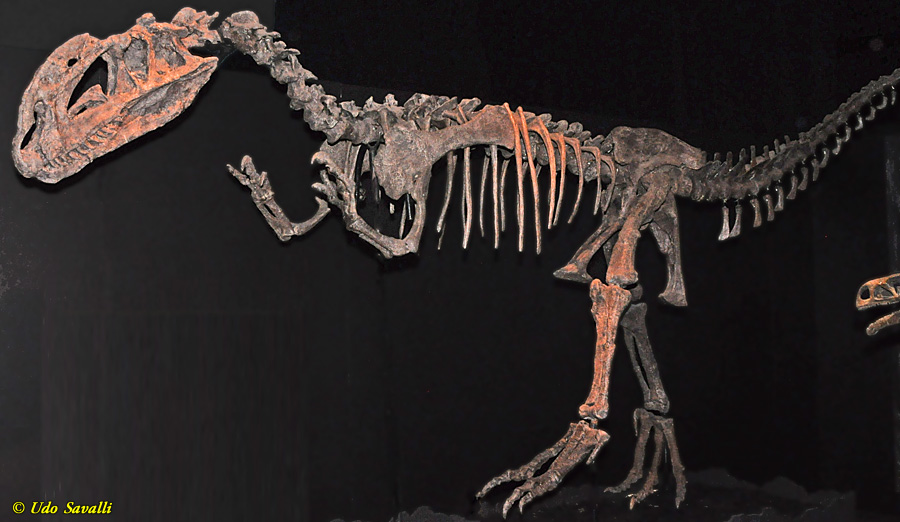
|
|
Ceratosauroids
|
The Ceratosauroidea is a clade of relatively primitive theropods with 4 fingers per hand. They vary in size from quite small (probably the ancestral condtion) to moderately large.
Ceratosaurus sp. is a large member of this clade.
Taxonomy: Theropoda, Ceratosauroidea, Ceratosauridae
Morrison Formation, western North America Late Jurassic Period, 153-148 Ma
Museum of Ancient Life, Utah
|
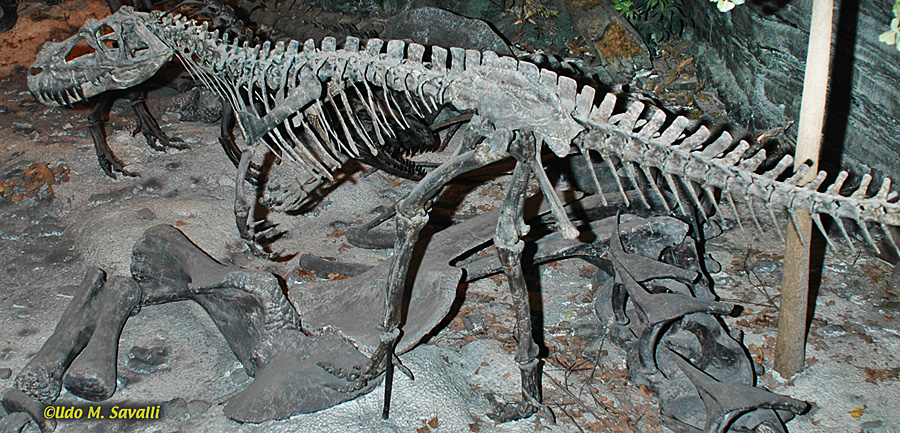
|
|
|
The Abelisauridae is a specialized family of large ceratosauroids characterized by extremely reduced, vestigial fore-limbs (but still with 4 fingers), and a relatively deep, often short, skull.
Carnotaurus sastrei is the best known member of this group
Taxonomy: Theropoda, Ceratosauroidea, Abelisauridae
Argentina
Late Cretaceous Period, 70-66 Ma
Los Angeles Museum of Natural History
|
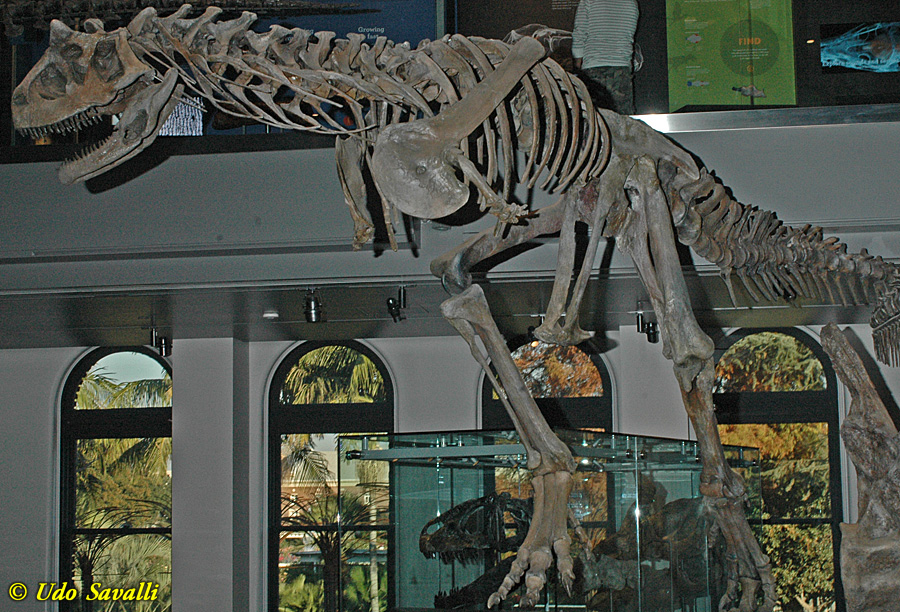
|
|
|
Many abelisaurids, such as this Majungasaurus crenatissimus, had horns or rugosities (roughened areas) on their skull.
Taxonomy: Theropoda, Ceratosauroidea, Abelisauridae
Madagascar
Late Cretaceous Period, 68-66 Ma
Los Angeles Museum of Natural History
|
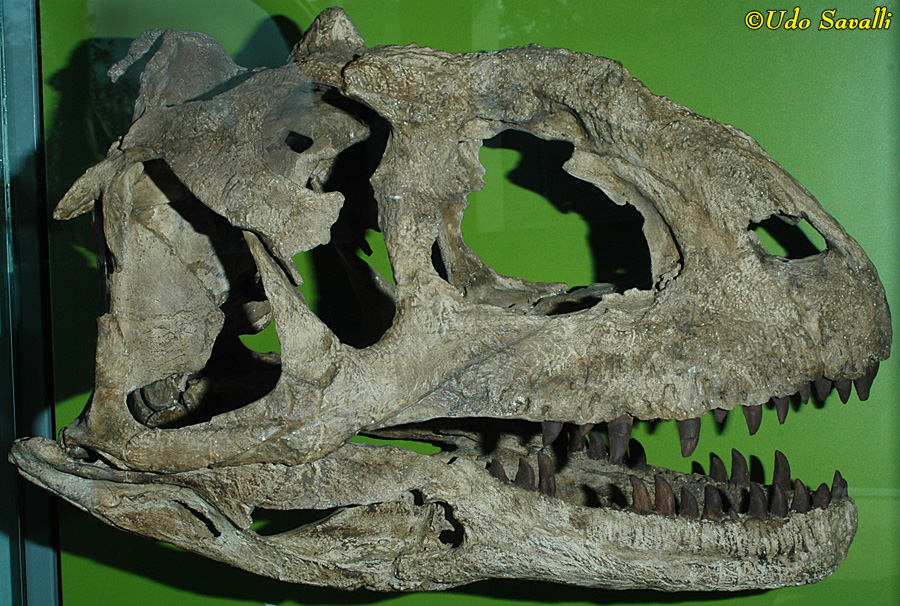
|
|
Megalosauroidea
|
The megalosauroidea is a clade of large-sized carnivores. Some, such as the megalosaurs are generalized predators similar to the allosauroidea (below), while the spinosaurs are specialized fish eaters and may have been semi-aquatic.
Torvosaurus sp. is a fairly typical member of the Megalosauridae family (that also includes Megalosaurus, the first named dinosaur), and looks similar to other large, generalized carnivores.
Taxonomy: Theropoda, Megalosauroidea, Megalosauridae
Morrison Formation, western North America
Late Jurassic Period, 150 Ma
Museum of Ancient Life, Utah
|
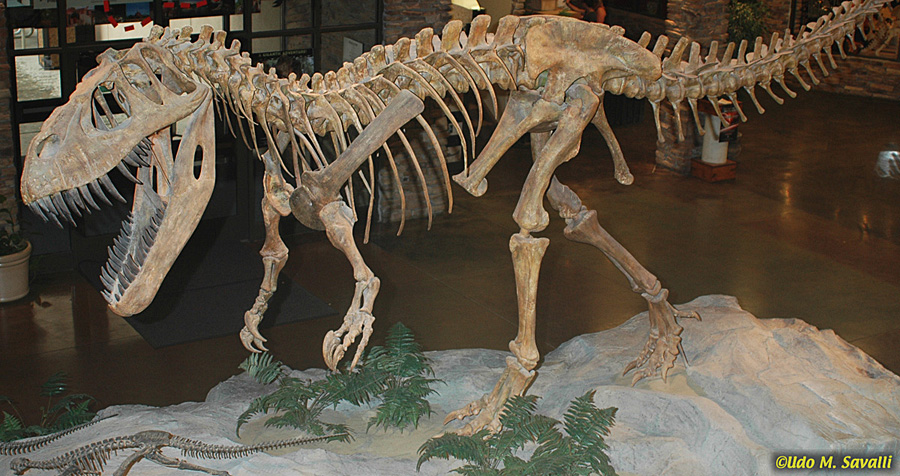
|
|
|
Monolophosaurus jiagni has a bony crest running along the middle of the snout. Its relationship to other theropods is undecided and it may or may not be part of the Megalosauroidea.
Taxonomy: Theropoda, Megalosauroidea?
China
Middle Jurassic Period, 170-165 Ma
Wyoming Dinosaur Center
|
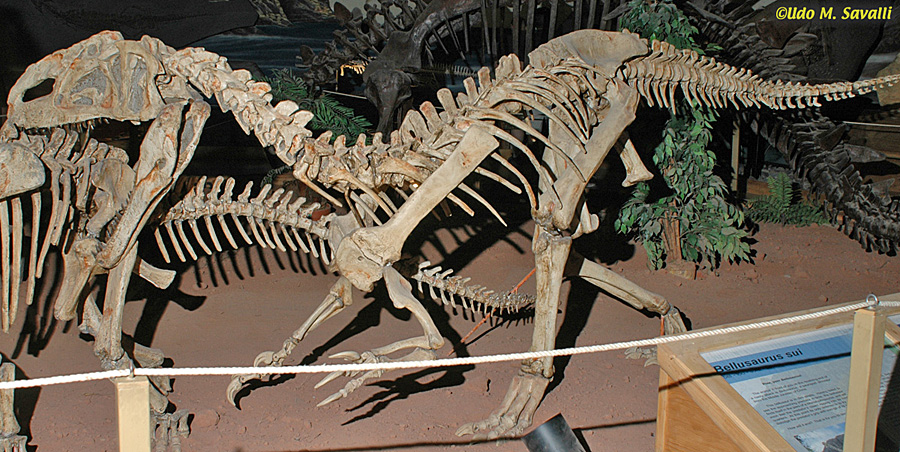
|
|
|
The Spinosauridae family is a specialized group of very large dinosaurs specialized for eating fish. Their skulls, as in this Suchomimus sp., are long, narrow and with a notch in the upper jaw similar to those found in some crocodylians.
Taxonomy: Theropoda, Megalosauroidea, Spinosauridae
Africa
Early Cretaceous Period, 112 Ma
Museum of Ancient Life, Utah
|
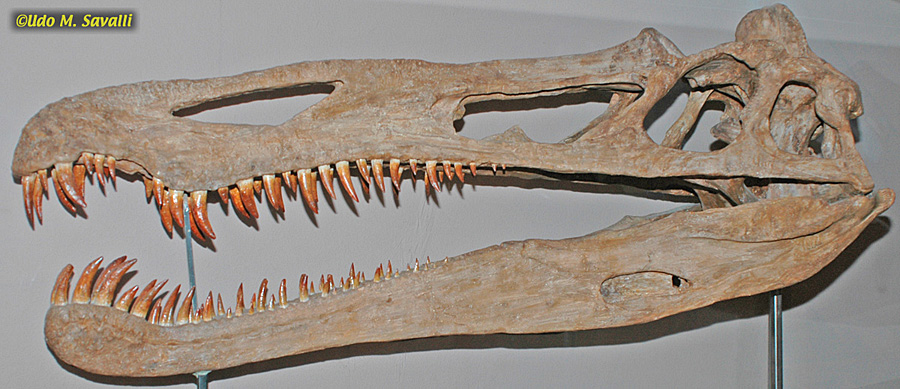
|
|
|
Cast of the rostrum (snout) of Spinosaurus sp., one of the largest theropods and most likely aquatic.
Taxonomy: Theropoda, Megalosauroidea, Spinosauridae
Morocco
Late Cretaceous Period, 99-93 Ma
Los Angeles Museum of Natural History
|

|
|
Allosauroidea (Carnosaurs)
|
The Allosauroidea (sometimes referred to as the Carnosauria) is a clade of very large carnivorous theropods. They are large-headed with fairly small forelimbs, and fairly uniform in overall body shape and proportions. Allosaurus fragilis is one of the best known members of this group; it is medium-sized, averaging about 8.5 m long.
Taxonomy: Theropoda, Allosauroidea, Allosauridae
Morrison Formation, western North America
Late Jurassic Period, 140 Ma
San Diego Natural History Museum
|
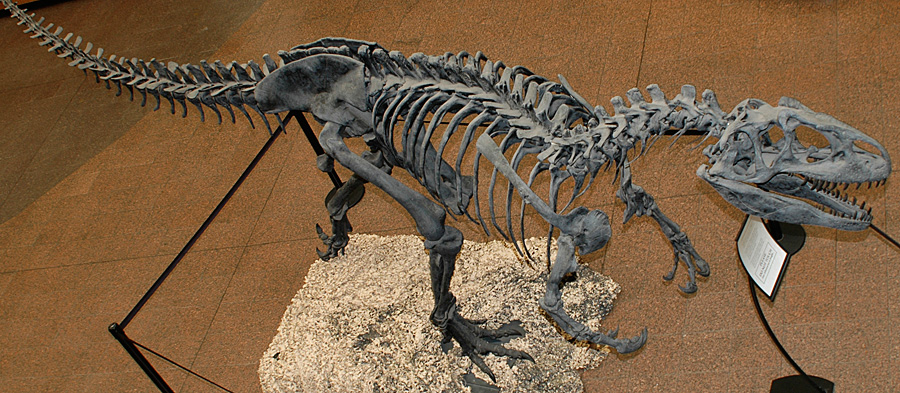
|
|
|
Allosaurus has been known since 1877, but a recent reexamination of the many existing specimens has indicated that it is actually composed of two separate species. This skull of A. fragilis shows one of the distinguishing characteristics, the upper jawline (jugal bone) is curved downward posterior to the teeth.
Taxonomy: Theropoda, Allosauroidea, Allosauridae
Morrison Formation, western North America
Late Jurassic Period, 140 Ma
San Diego Natural History Museum
|
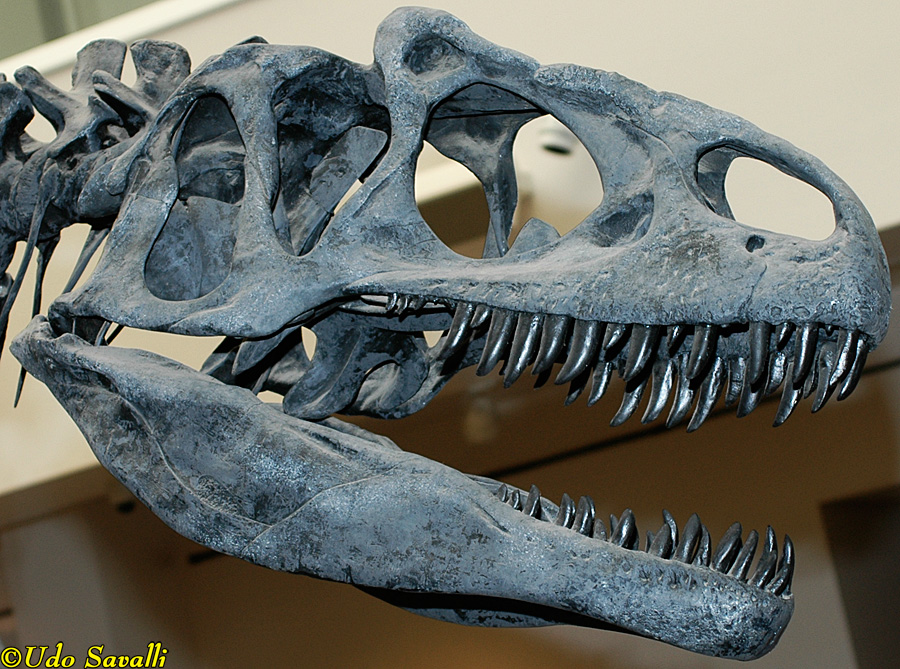
|
|
|
In contrast, the newly described Allosaurus jimmadseni has a straighter upper jawline than A. fragilis.
Taxonomy: Theropoda, Allosauroidea, Allosauridae
Morrison Formation, western North America
Late Jurassic Period, 155-150 Ma
Museum of Ancient Life, Utah
|
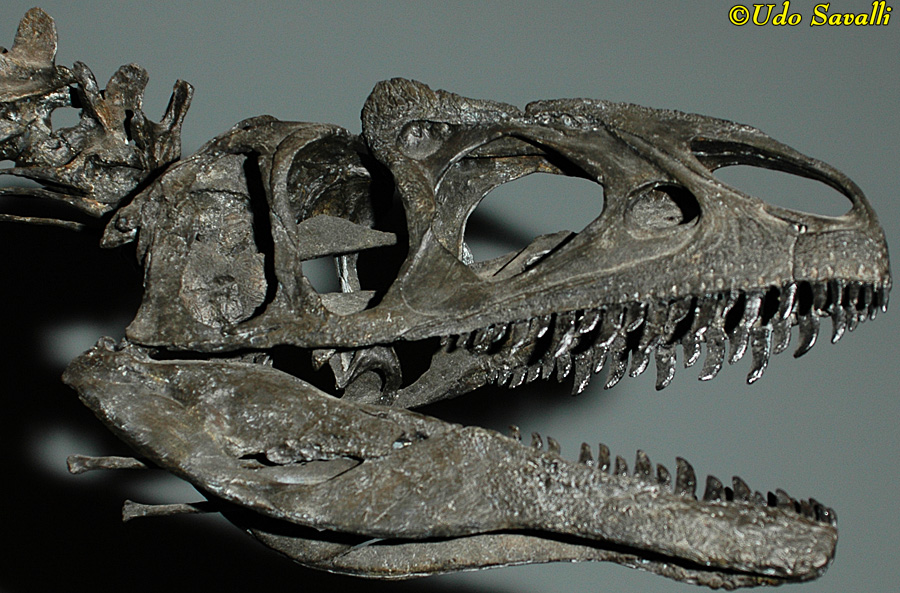
|
|
|
Examples of Allosaurus jimmadseni pathologies (disease and injury) of the manus (hand; top pair of bones) and pes (foot; rest of bones). In the three pairs of small bones, a normal bone is on the left with a pathological bone on the right. In the complete foot, note the damaged metatarsal and growth of bone tissue on the middle toe, probably arising from an infection following injury.
Taxonomy: Theropoda, Allosauroidea, Allosauridae
Big Horn Co., WY
Late Jurassic Period
Museum of the Rockies, Colorado
|
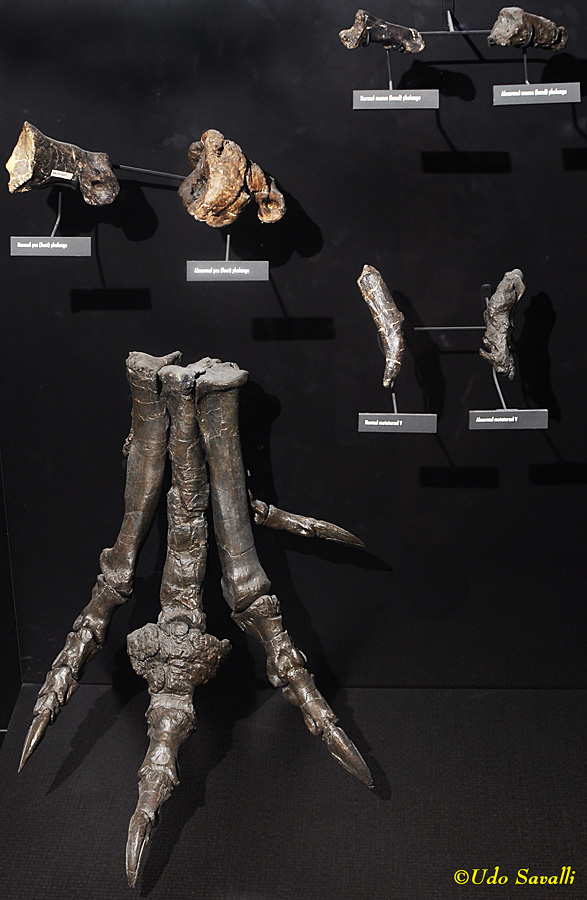
|
|
|
Saurophaganax maximus is closely related to Allosaurus, but is larger. Some paleontologists believe it to be just a species of Allosaurus.
Taxonomy: Theropoda, Allosauroidea, Allosauridae
Morrison Formation, New Mexico
Late Jurassic Period, 151 Ma
New Mexico Museum of Natural History & Science
|
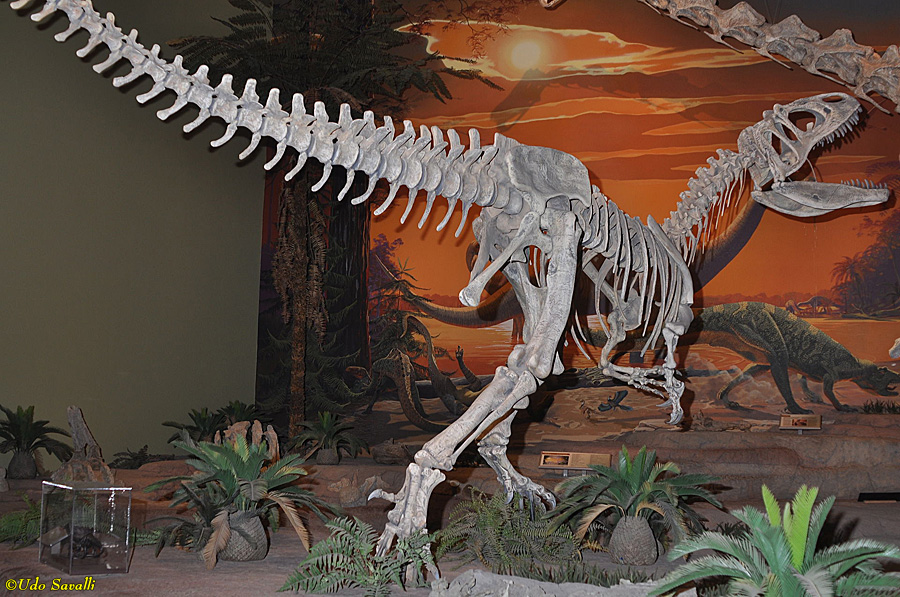
|
|
|
Giganotosaurus carolinii was a bit longer (13 m) than the famous Tyrannosaurus rex, but not as robust.
Taxonomy: Theropoda, Allosauroidea, Carcharodontosauridae
Argentina
Late Cretaceous Period, 98-96 Ma
Fernbank Museum of Natural History, Atlanta
|
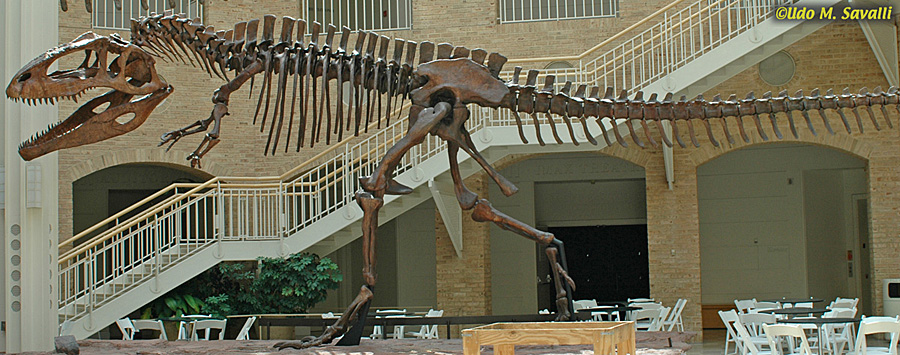
|
|
|
Mapusaurus sp. was cloesly related to Gigantosaurus, but a bit smaller in size. This skeleton is of a juvenile about half of adult size.
Taxonomy: Theropoda, Allosauroidea, Carcharodontosauridae
Argentina
Late Cretaceous, Cenomanian Stage, 95 Ma
Arizona Science Center (temporary exhibit)
|
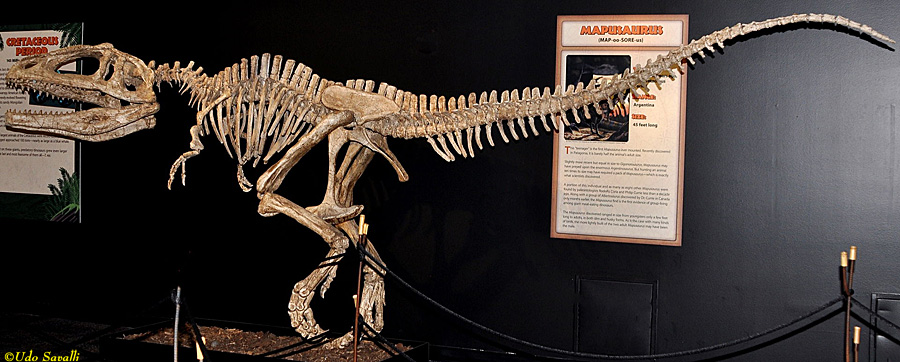
|
|
|
Acrocanthosaurus atokensis skull cast.
Taxonomy: Theropoda, Allosauroidea, Carcharodontosauridae
Paluxy Sandstone, Antlers Formation, McCurtain Co., OK
Early Cretaceous, Albion Stage, 100 Ma
Black Hills Institute Museum, South Dakota
|
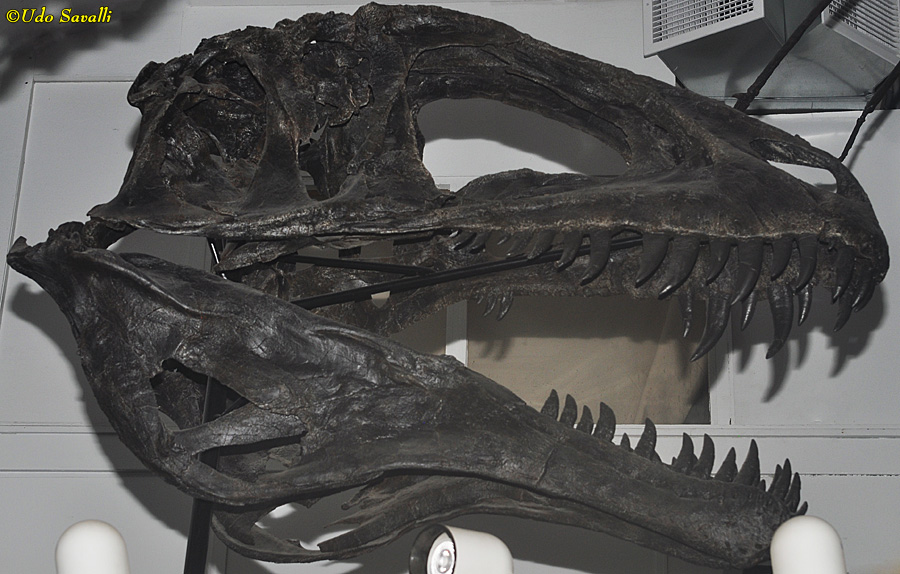
|
|
|






















